Organizational Behavior and Motivation at BBC: A Detailed Report
VerifiedAdded on 2020/07/22
|14
|4182
|40
Report
AI Summary
This report provides a comprehensive analysis of organizational behavior within the British Broadcasting Corporation (BBC). It begins by examining the historical organizational culture, utilizing Charles Handy's model to assess power dynamics, role culture, and task culture within the company. The analysis explores how culture, power, and politics have influenced employee behavior, including the impact of positive and negative power structures. The report then delves into motivation theories, differentiating between content and process theories, and applying Maslow's Hierarchy of Needs and Herzberg's Two-Factor Theory to improve team effectiveness. It assesses how motivational techniques can enhance employee performance, ultimately contributing to the achievement of organizational goals. The report also discusses various team types and factors that contribute to effective teamwork within BBC, alongside strategies to improve team performance and address potential barriers. Overall, the report aims to provide actionable insights into improving organizational behavior and performance within the BBC.
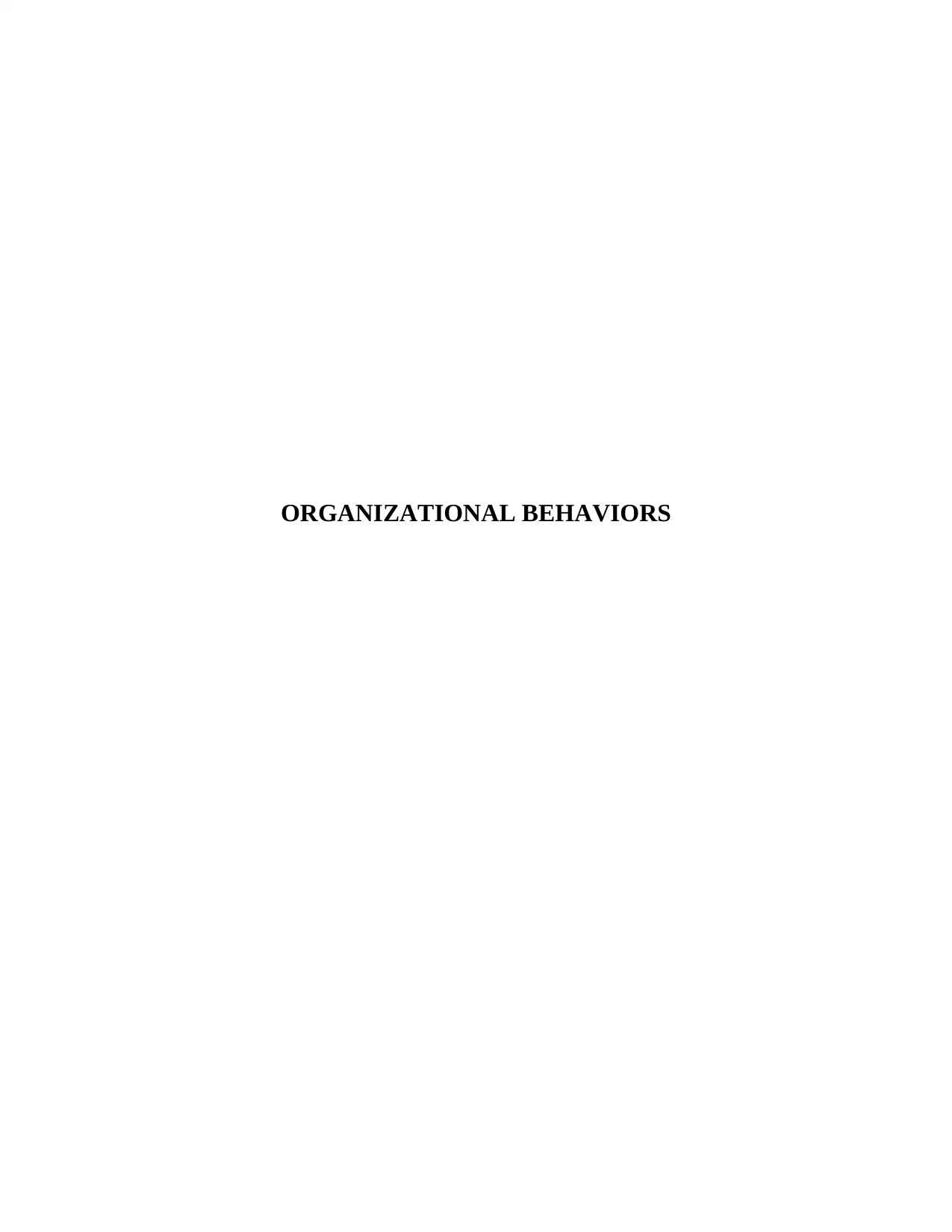
ORGANIZATIONAL BEHAVIORS
Paraphrase This Document
Need a fresh take? Get an instant paraphrase of this document with our AI Paraphraser
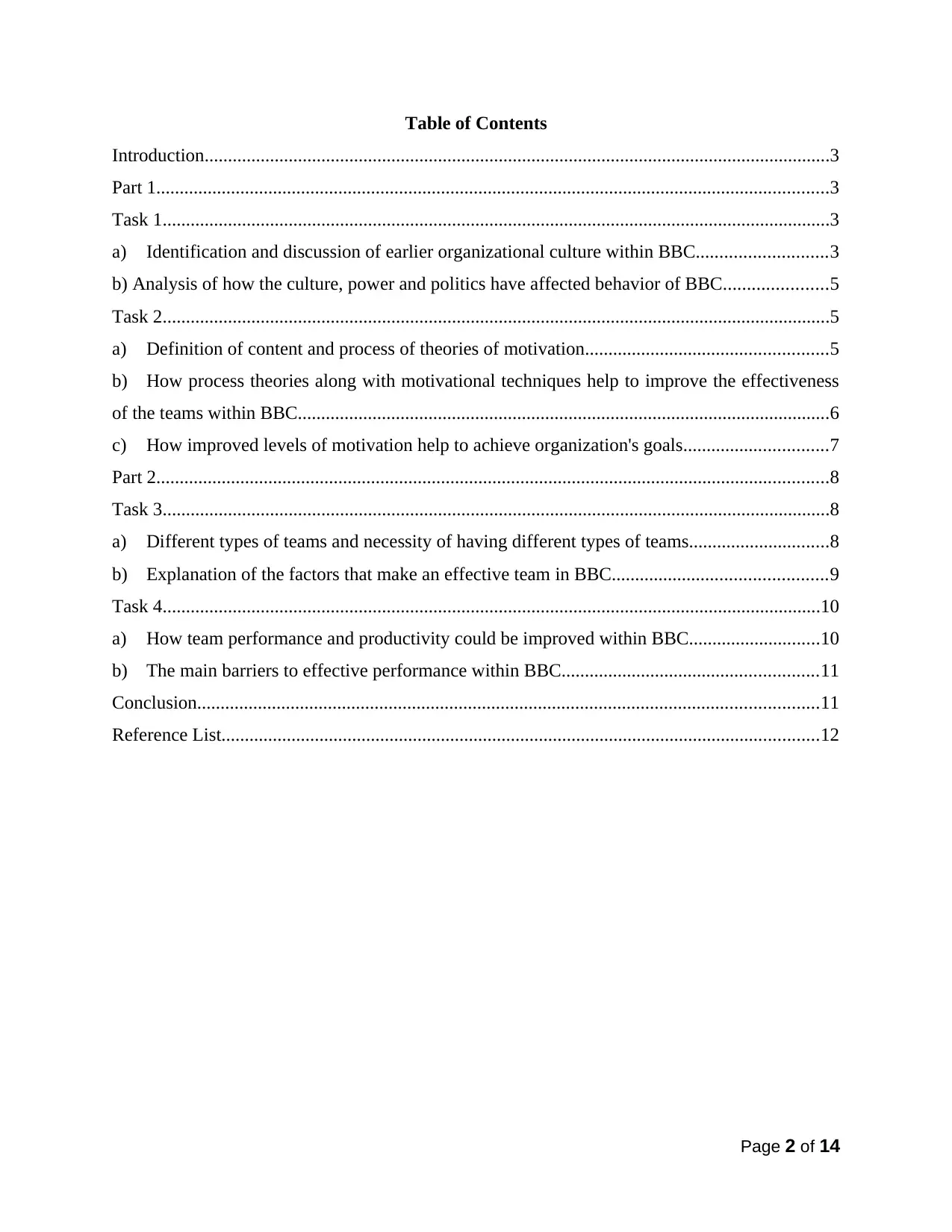
Table of Contents
Introduction......................................................................................................................................3
Part 1................................................................................................................................................3
Task 1...............................................................................................................................................3
a) Identification and discussion of earlier organizational culture within BBC............................3
b) Analysis of how the culture, power and politics have affected behavior of BBC......................5
Task 2...............................................................................................................................................5
a) Definition of content and process of theories of motivation....................................................5
b) How process theories along with motivational techniques help to improve the effectiveness
of the teams within BBC..................................................................................................................6
c) How improved levels of motivation help to achieve organization's goals...............................7
Part 2................................................................................................................................................8
Task 3...............................................................................................................................................8
a) Different types of teams and necessity of having different types of teams..............................8
b) Explanation of the factors that make an effective team in BBC..............................................9
Task 4.............................................................................................................................................10
a) How team performance and productivity could be improved within BBC............................10
b) The main barriers to effective performance within BBC.......................................................11
Conclusion.....................................................................................................................................11
Reference List................................................................................................................................12
Page 2 of 14
Introduction......................................................................................................................................3
Part 1................................................................................................................................................3
Task 1...............................................................................................................................................3
a) Identification and discussion of earlier organizational culture within BBC............................3
b) Analysis of how the culture, power and politics have affected behavior of BBC......................5
Task 2...............................................................................................................................................5
a) Definition of content and process of theories of motivation....................................................5
b) How process theories along with motivational techniques help to improve the effectiveness
of the teams within BBC..................................................................................................................6
c) How improved levels of motivation help to achieve organization's goals...............................7
Part 2................................................................................................................................................8
Task 3...............................................................................................................................................8
a) Different types of teams and necessity of having different types of teams..............................8
b) Explanation of the factors that make an effective team in BBC..............................................9
Task 4.............................................................................................................................................10
a) How team performance and productivity could be improved within BBC............................10
b) The main barriers to effective performance within BBC.......................................................11
Conclusion.....................................................................................................................................11
Reference List................................................................................................................................12
Page 2 of 14
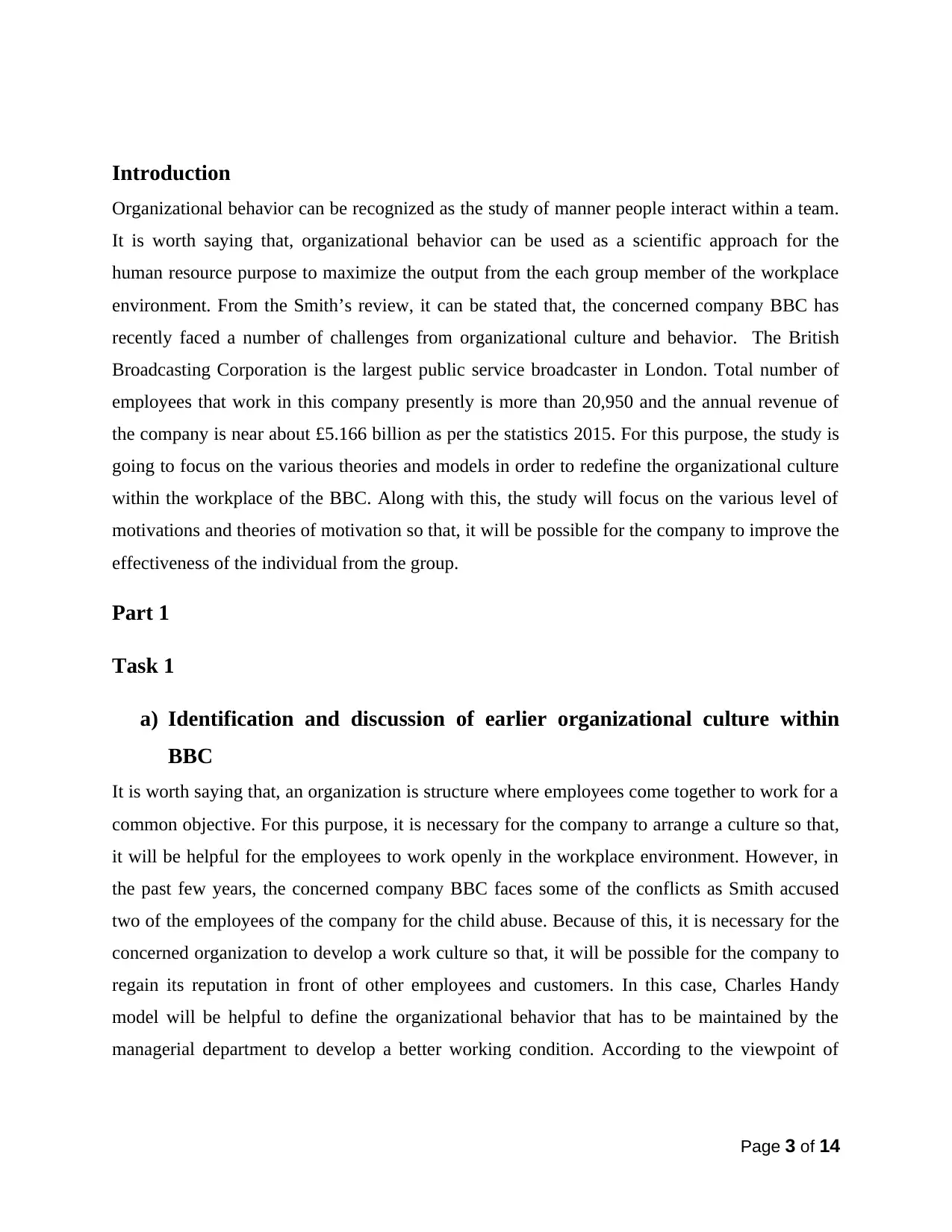
Introduction
Organizational behavior can be recognized as the study of manner people interact within a team.
It is worth saying that, organizational behavior can be used as a scientific approach for the
human resource purpose to maximize the output from the each group member of the workplace
environment. From the Smith’s review, it can be stated that, the concerned company BBC has
recently faced a number of challenges from organizational culture and behavior. The British
Broadcasting Corporation is the largest public service broadcaster in London. Total number of
employees that work in this company presently is more than 20,950 and the annual revenue of
the company is near about £5.166 billion as per the statistics 2015. For this purpose, the study is
going to focus on the various theories and models in order to redefine the organizational culture
within the workplace of the BBC. Along with this, the study will focus on the various level of
motivations and theories of motivation so that, it will be possible for the company to improve the
effectiveness of the individual from the group.
Part 1
Task 1
a) Identification and discussion of earlier organizational culture within
BBC
It is worth saying that, an organization is structure where employees come together to work for a
common objective. For this purpose, it is necessary for the company to arrange a culture so that,
it will be helpful for the employees to work openly in the workplace environment. However, in
the past few years, the concerned company BBC faces some of the conflicts as Smith accused
two of the employees of the company for the child abuse. Because of this, it is necessary for the
concerned organization to develop a work culture so that, it will be possible for the company to
regain its reputation in front of other employees and customers. In this case, Charles Handy
model will be helpful to define the organizational behavior that has to be maintained by the
managerial department to develop a better working condition. According to the viewpoint of
Page 3 of 14
Organizational behavior can be recognized as the study of manner people interact within a team.
It is worth saying that, organizational behavior can be used as a scientific approach for the
human resource purpose to maximize the output from the each group member of the workplace
environment. From the Smith’s review, it can be stated that, the concerned company BBC has
recently faced a number of challenges from organizational culture and behavior. The British
Broadcasting Corporation is the largest public service broadcaster in London. Total number of
employees that work in this company presently is more than 20,950 and the annual revenue of
the company is near about £5.166 billion as per the statistics 2015. For this purpose, the study is
going to focus on the various theories and models in order to redefine the organizational culture
within the workplace of the BBC. Along with this, the study will focus on the various level of
motivations and theories of motivation so that, it will be possible for the company to improve the
effectiveness of the individual from the group.
Part 1
Task 1
a) Identification and discussion of earlier organizational culture within
BBC
It is worth saying that, an organization is structure where employees come together to work for a
common objective. For this purpose, it is necessary for the company to arrange a culture so that,
it will be helpful for the employees to work openly in the workplace environment. However, in
the past few years, the concerned company BBC faces some of the conflicts as Smith accused
two of the employees of the company for the child abuse. Because of this, it is necessary for the
concerned organization to develop a work culture so that, it will be possible for the company to
regain its reputation in front of other employees and customers. In this case, Charles Handy
model will be helpful to define the organizational behavior that has to be maintained by the
managerial department to develop a better working condition. According to the viewpoint of
Page 3 of 14
⊘ This is a preview!⊘
Do you want full access?
Subscribe today to unlock all pages.

Trusted by 1+ million students worldwide
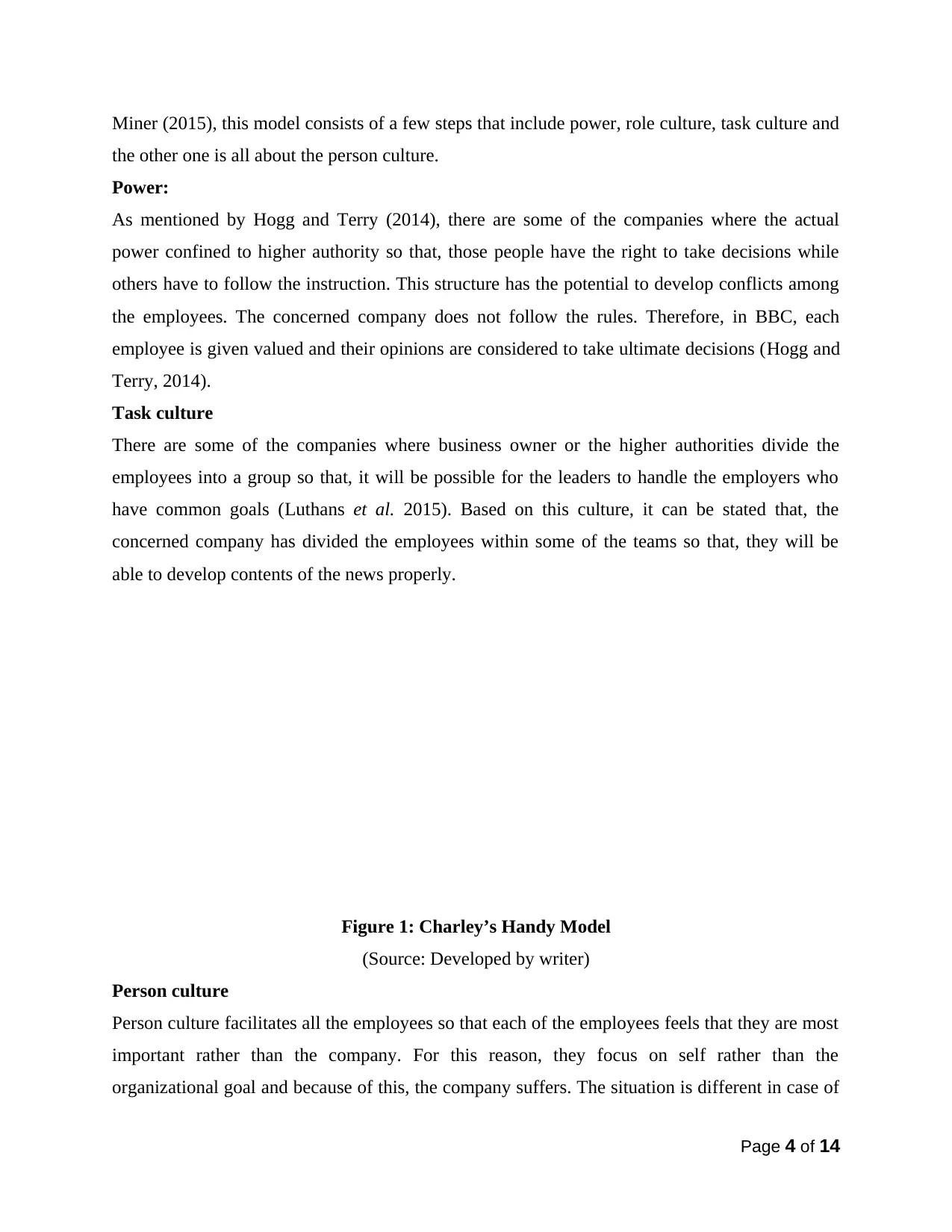
Miner (2015), this model consists of a few steps that include power, role culture, task culture and
the other one is all about the person culture.
Power:
As mentioned by Hogg and Terry (2014), there are some of the companies where the actual
power confined to higher authority so that, those people have the right to take decisions while
others have to follow the instruction. This structure has the potential to develop conflicts among
the employees. The concerned company does not follow the rules. Therefore, in BBC, each
employee is given valued and their opinions are considered to take ultimate decisions (Hogg and
Terry, 2014).
Task culture
There are some of the companies where business owner or the higher authorities divide the
employees into a group so that, it will be possible for the leaders to handle the employers who
have common goals (Luthans et al. 2015). Based on this culture, it can be stated that, the
concerned company has divided the employees within some of the teams so that, they will be
able to develop contents of the news properly.
Figure 1: Charley’s Handy Model
(Source: Developed by writer)
Person culture
Person culture facilitates all the employees so that each of the employees feels that they are most
important rather than the company. For this reason, they focus on self rather than the
organizational goal and because of this, the company suffers. The situation is different in case of
Page 4 of 14
the other one is all about the person culture.
Power:
As mentioned by Hogg and Terry (2014), there are some of the companies where the actual
power confined to higher authority so that, those people have the right to take decisions while
others have to follow the instruction. This structure has the potential to develop conflicts among
the employees. The concerned company does not follow the rules. Therefore, in BBC, each
employee is given valued and their opinions are considered to take ultimate decisions (Hogg and
Terry, 2014).
Task culture
There are some of the companies where business owner or the higher authorities divide the
employees into a group so that, it will be possible for the leaders to handle the employers who
have common goals (Luthans et al. 2015). Based on this culture, it can be stated that, the
concerned company has divided the employees within some of the teams so that, they will be
able to develop contents of the news properly.
Figure 1: Charley’s Handy Model
(Source: Developed by writer)
Person culture
Person culture facilitates all the employees so that each of the employees feels that they are most
important rather than the company. For this reason, they focus on self rather than the
organizational goal and because of this, the company suffers. The situation is different in case of
Page 4 of 14
Paraphrase This Document
Need a fresh take? Get an instant paraphrase of this document with our AI Paraphraser
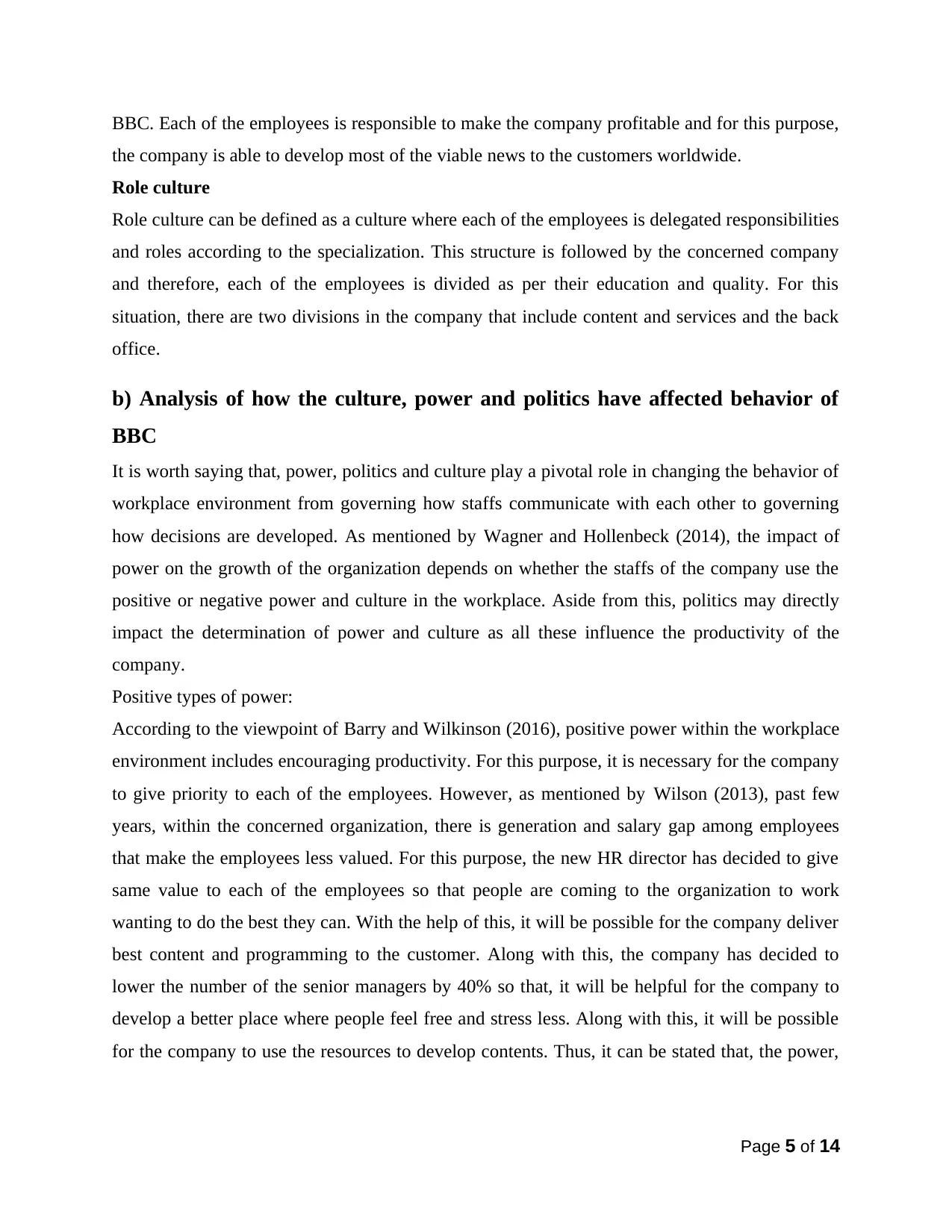
BBC. Each of the employees is responsible to make the company profitable and for this purpose,
the company is able to develop most of the viable news to the customers worldwide.
Role culture
Role culture can be defined as a culture where each of the employees is delegated responsibilities
and roles according to the specialization. This structure is followed by the concerned company
and therefore, each of the employees is divided as per their education and quality. For this
situation, there are two divisions in the company that include content and services and the back
office.
b) Analysis of how the culture, power and politics have affected behavior of
BBC
It is worth saying that, power, politics and culture play a pivotal role in changing the behavior of
workplace environment from governing how staffs communicate with each other to governing
how decisions are developed. As mentioned by Wagner and Hollenbeck (2014), the impact of
power on the growth of the organization depends on whether the staffs of the company use the
positive or negative power and culture in the workplace. Aside from this, politics may directly
impact the determination of power and culture as all these influence the productivity of the
company.
Positive types of power:
According to the viewpoint of Barry and Wilkinson (2016), positive power within the workplace
environment includes encouraging productivity. For this purpose, it is necessary for the company
to give priority to each of the employees. However, as mentioned by Wilson (2013), past few
years, within the concerned organization, there is generation and salary gap among employees
that make the employees less valued. For this purpose, the new HR director has decided to give
same value to each of the employees so that people are coming to the organization to work
wanting to do the best they can. With the help of this, it will be possible for the company deliver
best content and programming to the customer. Along with this, the company has decided to
lower the number of the senior managers by 40% so that, it will be helpful for the company to
develop a better place where people feel free and stress less. Along with this, it will be possible
for the company to use the resources to develop contents. Thus, it can be stated that, the power,
Page 5 of 14
the company is able to develop most of the viable news to the customers worldwide.
Role culture
Role culture can be defined as a culture where each of the employees is delegated responsibilities
and roles according to the specialization. This structure is followed by the concerned company
and therefore, each of the employees is divided as per their education and quality. For this
situation, there are two divisions in the company that include content and services and the back
office.
b) Analysis of how the culture, power and politics have affected behavior of
BBC
It is worth saying that, power, politics and culture play a pivotal role in changing the behavior of
workplace environment from governing how staffs communicate with each other to governing
how decisions are developed. As mentioned by Wagner and Hollenbeck (2014), the impact of
power on the growth of the organization depends on whether the staffs of the company use the
positive or negative power and culture in the workplace. Aside from this, politics may directly
impact the determination of power and culture as all these influence the productivity of the
company.
Positive types of power:
According to the viewpoint of Barry and Wilkinson (2016), positive power within the workplace
environment includes encouraging productivity. For this purpose, it is necessary for the company
to give priority to each of the employees. However, as mentioned by Wilson (2013), past few
years, within the concerned organization, there is generation and salary gap among employees
that make the employees less valued. For this purpose, the new HR director has decided to give
same value to each of the employees so that people are coming to the organization to work
wanting to do the best they can. With the help of this, it will be possible for the company deliver
best content and programming to the customer. Along with this, the company has decided to
lower the number of the senior managers by 40% so that, it will be helpful for the company to
develop a better place where people feel free and stress less. Along with this, it will be possible
for the company to use the resources to develop contents. Thus, it can be stated that, the power,
Page 5 of 14
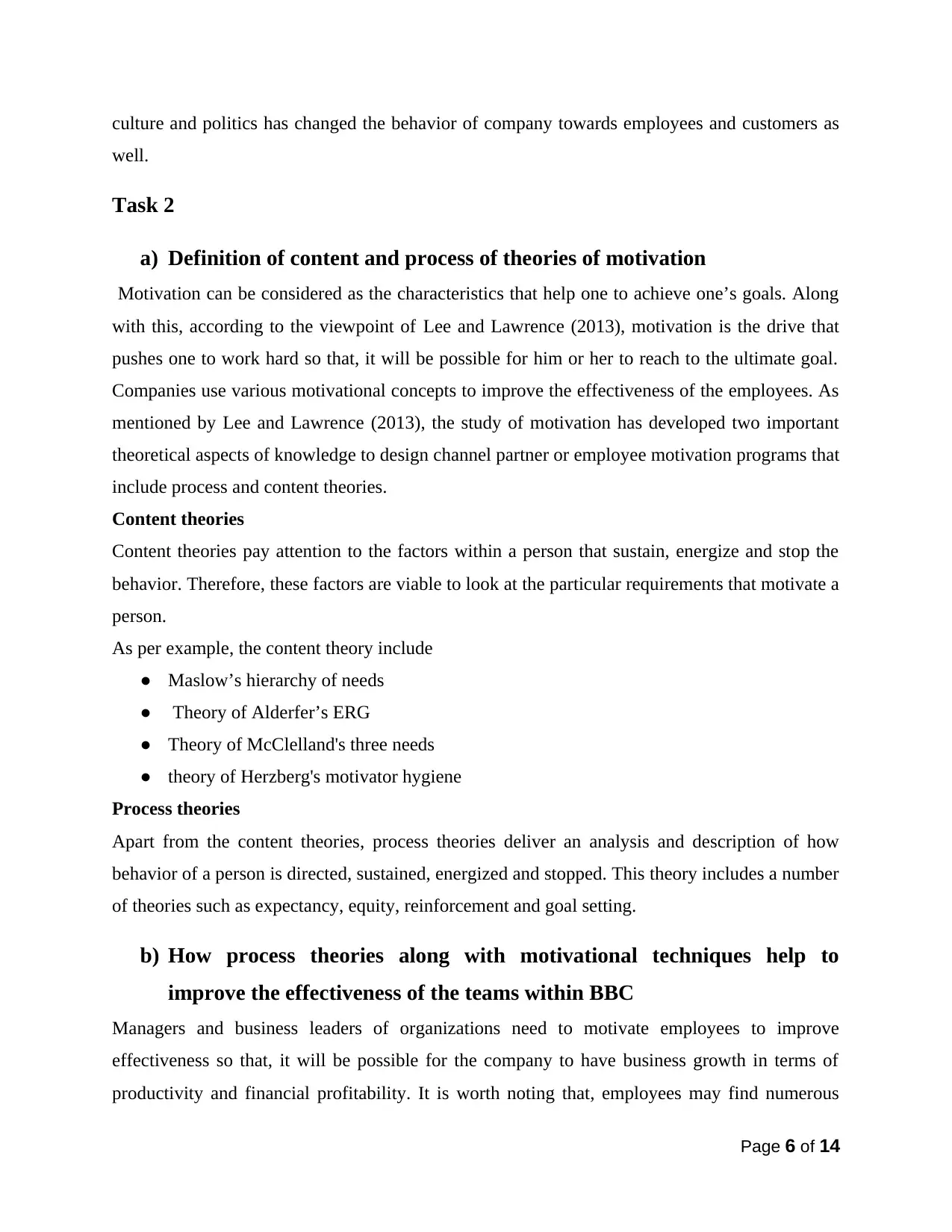
culture and politics has changed the behavior of company towards employees and customers as
well.
Task 2
a) Definition of content and process of theories of motivation
Motivation can be considered as the characteristics that help one to achieve one’s goals. Along
with this, according to the viewpoint of Lee and Lawrence (2013), motivation is the drive that
pushes one to work hard so that, it will be possible for him or her to reach to the ultimate goal.
Companies use various motivational concepts to improve the effectiveness of the employees. As
mentioned by Lee and Lawrence (2013), the study of motivation has developed two important
theoretical aspects of knowledge to design channel partner or employee motivation programs that
include process and content theories.
Content theories
Content theories pay attention to the factors within a person that sustain, energize and stop the
behavior. Therefore, these factors are viable to look at the particular requirements that motivate a
person.
As per example, the content theory include
● Maslow’s hierarchy of needs
● Theory of Alderfer’s ERG
● Theory of McClelland's three needs
● theory of Herzberg's motivator hygiene
Process theories
Apart from the content theories, process theories deliver an analysis and description of how
behavior of a person is directed, sustained, energized and stopped. This theory includes a number
of theories such as expectancy, equity, reinforcement and goal setting.
b) How process theories along with motivational techniques help to
improve the effectiveness of the teams within BBC
Managers and business leaders of organizations need to motivate employees to improve
effectiveness so that, it will be possible for the company to have business growth in terms of
productivity and financial profitability. It is worth noting that, employees may find numerous
Page 6 of 14
well.
Task 2
a) Definition of content and process of theories of motivation
Motivation can be considered as the characteristics that help one to achieve one’s goals. Along
with this, according to the viewpoint of Lee and Lawrence (2013), motivation is the drive that
pushes one to work hard so that, it will be possible for him or her to reach to the ultimate goal.
Companies use various motivational concepts to improve the effectiveness of the employees. As
mentioned by Lee and Lawrence (2013), the study of motivation has developed two important
theoretical aspects of knowledge to design channel partner or employee motivation programs that
include process and content theories.
Content theories
Content theories pay attention to the factors within a person that sustain, energize and stop the
behavior. Therefore, these factors are viable to look at the particular requirements that motivate a
person.
As per example, the content theory include
● Maslow’s hierarchy of needs
● Theory of Alderfer’s ERG
● Theory of McClelland's three needs
● theory of Herzberg's motivator hygiene
Process theories
Apart from the content theories, process theories deliver an analysis and description of how
behavior of a person is directed, sustained, energized and stopped. This theory includes a number
of theories such as expectancy, equity, reinforcement and goal setting.
b) How process theories along with motivational techniques help to
improve the effectiveness of the teams within BBC
Managers and business leaders of organizations need to motivate employees to improve
effectiveness so that, it will be possible for the company to have business growth in terms of
productivity and financial profitability. It is worth noting that, employees may find numerous
Page 6 of 14
⊘ This is a preview!⊘
Do you want full access?
Subscribe today to unlock all pages.

Trusted by 1+ million students worldwide
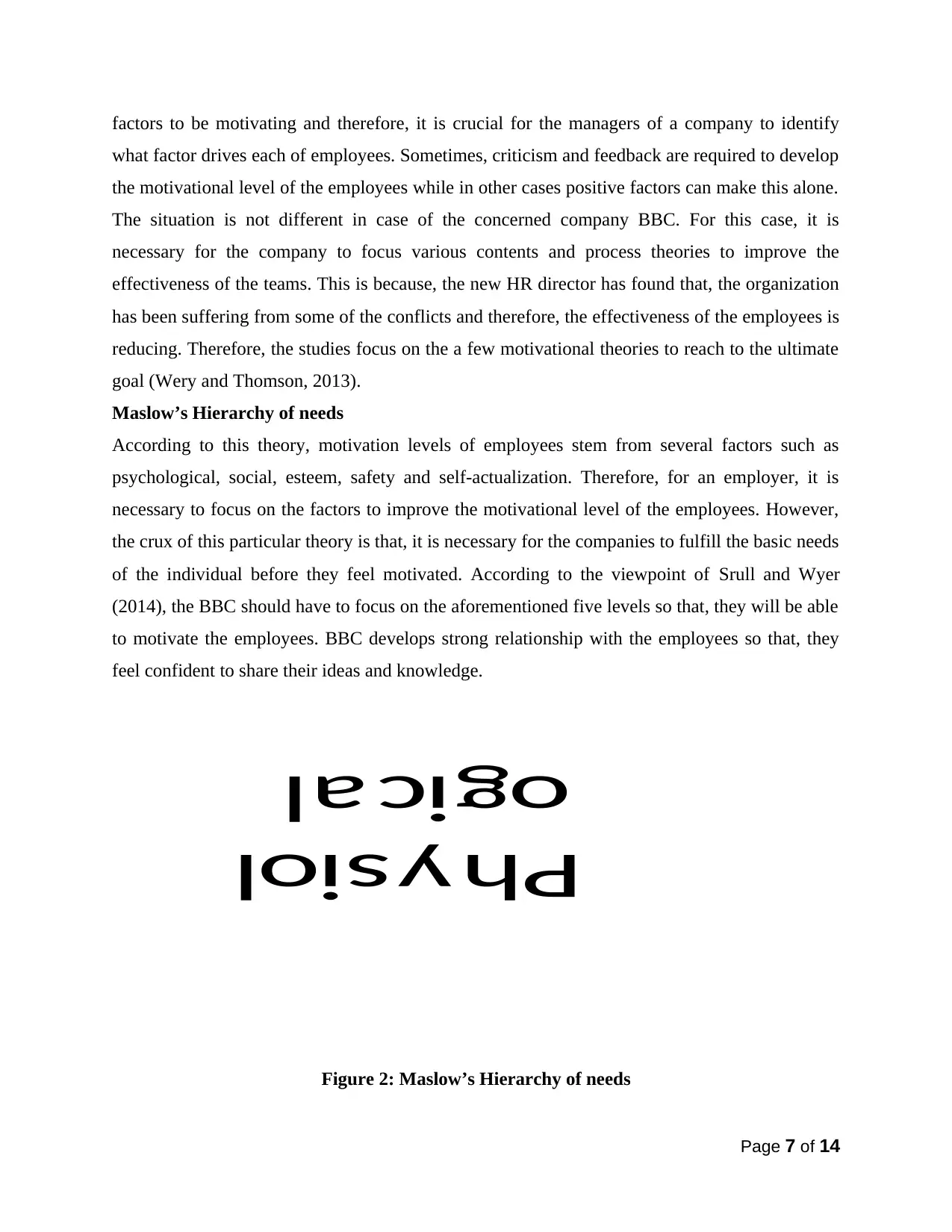
factors to be motivating and therefore, it is crucial for the managers of a company to identify
what factor drives each of employees. Sometimes, criticism and feedback are required to develop
the motivational level of the employees while in other cases positive factors can make this alone.
The situation is not different in case of the concerned company BBC. For this case, it is
necessary for the company to focus various contents and process theories to improve the
effectiveness of the teams. This is because, the new HR director has found that, the organization
has been suffering from some of the conflicts and therefore, the effectiveness of the employees is
reducing. Therefore, the studies focus on the a few motivational theories to reach to the ultimate
goal (Wery and Thomson, 2013).
Maslow’s Hierarchy of needs
According to this theory, motivation levels of employees stem from several factors such as
psychological, social, esteem, safety and self-actualization. Therefore, for an employer, it is
necessary to focus on the factors to improve the motivational level of the employees. However,
the crux of this particular theory is that, it is necessary for the companies to fulfill the basic needs
of the individual before they feel motivated. According to the viewpoint of Srull and Wyer
(2014), the BBC should have to focus on the aforementioned five levels so that, they will be able
to motivate the employees. BBC develops strong relationship with the employees so that, they
feel confident to share their ideas and knowledge.
Figure 2: Maslow’s Hierarchy of needs
Page 7 of 14
Self-
actualiz a
tion
Estee
m
Love /
belongin
g
safety
Physiol
ogical
what factor drives each of employees. Sometimes, criticism and feedback are required to develop
the motivational level of the employees while in other cases positive factors can make this alone.
The situation is not different in case of the concerned company BBC. For this case, it is
necessary for the company to focus various contents and process theories to improve the
effectiveness of the teams. This is because, the new HR director has found that, the organization
has been suffering from some of the conflicts and therefore, the effectiveness of the employees is
reducing. Therefore, the studies focus on the a few motivational theories to reach to the ultimate
goal (Wery and Thomson, 2013).
Maslow’s Hierarchy of needs
According to this theory, motivation levels of employees stem from several factors such as
psychological, social, esteem, safety and self-actualization. Therefore, for an employer, it is
necessary to focus on the factors to improve the motivational level of the employees. However,
the crux of this particular theory is that, it is necessary for the companies to fulfill the basic needs
of the individual before they feel motivated. According to the viewpoint of Srull and Wyer
(2014), the BBC should have to focus on the aforementioned five levels so that, they will be able
to motivate the employees. BBC develops strong relationship with the employees so that, they
feel confident to share their ideas and knowledge.
Figure 2: Maslow’s Hierarchy of needs
Page 7 of 14
Self-
actualiz a
tion
Estee
m
Love /
belongin
g
safety
Physiol
ogical
Paraphrase This Document
Need a fresh take? Get an instant paraphrase of this document with our AI Paraphraser
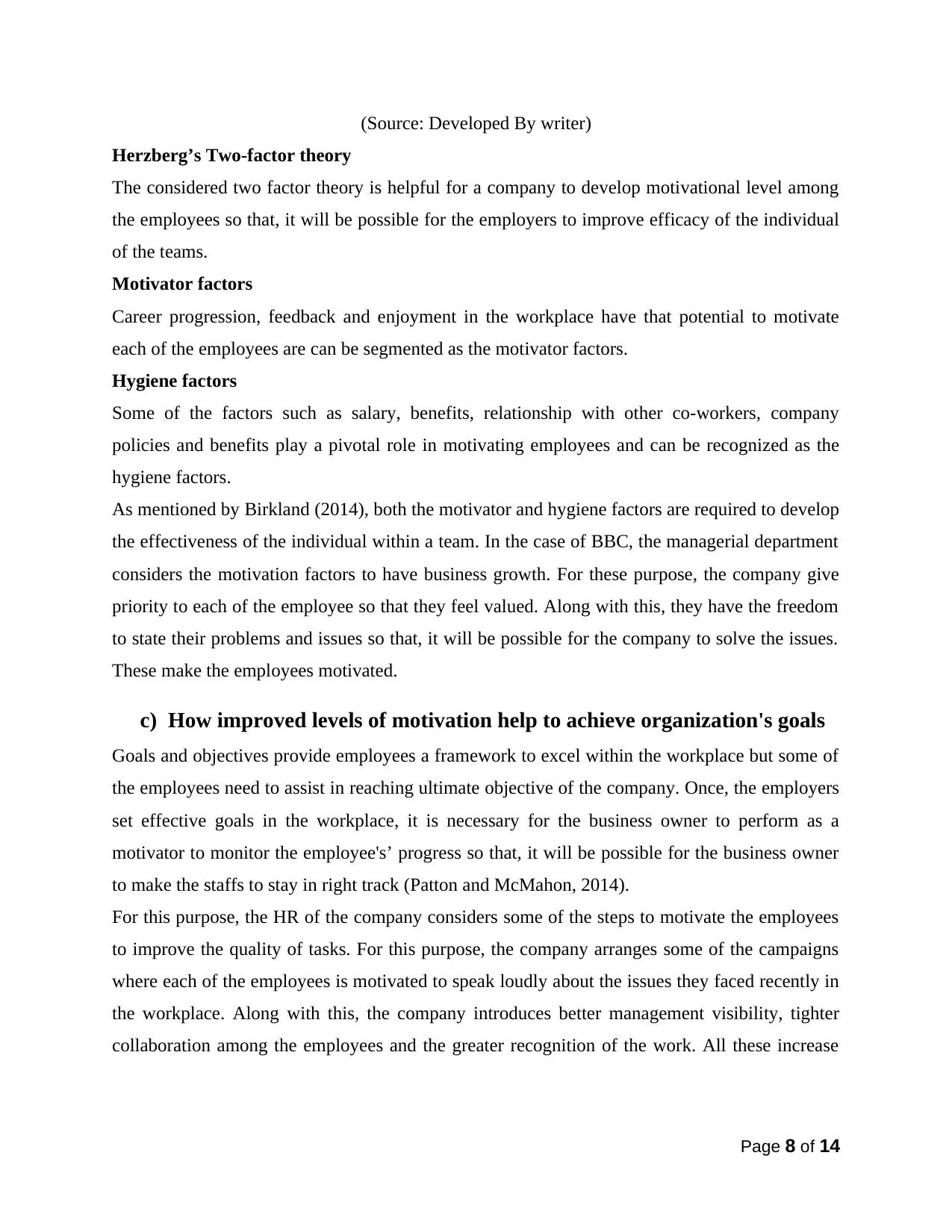
(Source: Developed By writer)
Herzberg’s Two-factor theory
The considered two factor theory is helpful for a company to develop motivational level among
the employees so that, it will be possible for the employers to improve efficacy of the individual
of the teams.
Motivator factors
Career progression, feedback and enjoyment in the workplace have that potential to motivate
each of the employees are can be segmented as the motivator factors.
Hygiene factors
Some of the factors such as salary, benefits, relationship with other co-workers, company
policies and benefits play a pivotal role in motivating employees and can be recognized as the
hygiene factors.
As mentioned by Birkland (2014), both the motivator and hygiene factors are required to develop
the effectiveness of the individual within a team. In the case of BBC, the managerial department
considers the motivation factors to have business growth. For these purpose, the company give
priority to each of the employee so that they feel valued. Along with this, they have the freedom
to state their problems and issues so that, it will be possible for the company to solve the issues.
These make the employees motivated.
c) How improved levels of motivation help to achieve organization's goals
Goals and objectives provide employees a framework to excel within the workplace but some of
the employees need to assist in reaching ultimate objective of the company. Once, the employers
set effective goals in the workplace, it is necessary for the business owner to perform as a
motivator to monitor the employee's’ progress so that, it will be possible for the business owner
to make the staffs to stay in right track (Patton and McMahon, 2014).
For this purpose, the HR of the company considers some of the steps to motivate the employees
to improve the quality of tasks. For this purpose, the company arranges some of the campaigns
where each of the employees is motivated to speak loudly about the issues they faced recently in
the workplace. Along with this, the company introduces better management visibility, tighter
collaboration among the employees and the greater recognition of the work. All these increase
Page 8 of 14
Herzberg’s Two-factor theory
The considered two factor theory is helpful for a company to develop motivational level among
the employees so that, it will be possible for the employers to improve efficacy of the individual
of the teams.
Motivator factors
Career progression, feedback and enjoyment in the workplace have that potential to motivate
each of the employees are can be segmented as the motivator factors.
Hygiene factors
Some of the factors such as salary, benefits, relationship with other co-workers, company
policies and benefits play a pivotal role in motivating employees and can be recognized as the
hygiene factors.
As mentioned by Birkland (2014), both the motivator and hygiene factors are required to develop
the effectiveness of the individual within a team. In the case of BBC, the managerial department
considers the motivation factors to have business growth. For these purpose, the company give
priority to each of the employee so that they feel valued. Along with this, they have the freedom
to state their problems and issues so that, it will be possible for the company to solve the issues.
These make the employees motivated.
c) How improved levels of motivation help to achieve organization's goals
Goals and objectives provide employees a framework to excel within the workplace but some of
the employees need to assist in reaching ultimate objective of the company. Once, the employers
set effective goals in the workplace, it is necessary for the business owner to perform as a
motivator to monitor the employee's’ progress so that, it will be possible for the business owner
to make the staffs to stay in right track (Patton and McMahon, 2014).
For this purpose, the HR of the company considers some of the steps to motivate the employees
to improve the quality of tasks. For this purpose, the company arranges some of the campaigns
where each of the employees is motivated to speak loudly about the issues they faced recently in
the workplace. Along with this, the company introduces better management visibility, tighter
collaboration among the employees and the greater recognition of the work. All these increase
Page 8 of 14
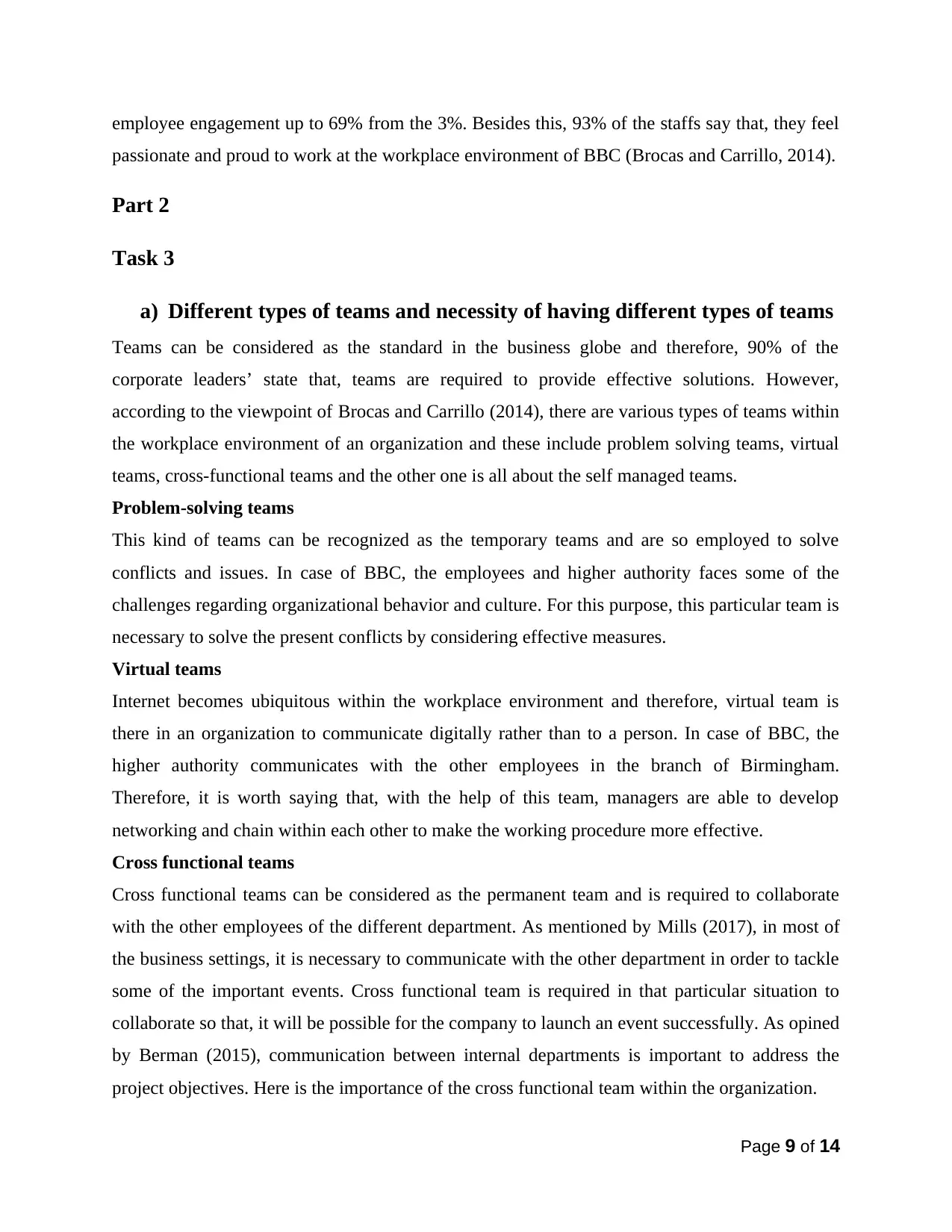
employee engagement up to 69% from the 3%. Besides this, 93% of the staffs say that, they feel
passionate and proud to work at the workplace environment of BBC (Brocas and Carrillo, 2014).
Part 2
Task 3
a) Different types of teams and necessity of having different types of teams
Teams can be considered as the standard in the business globe and therefore, 90% of the
corporate leaders’ state that, teams are required to provide effective solutions. However,
according to the viewpoint of Brocas and Carrillo (2014), there are various types of teams within
the workplace environment of an organization and these include problem solving teams, virtual
teams, cross-functional teams and the other one is all about the self managed teams.
Problem-solving teams
This kind of teams can be recognized as the temporary teams and are so employed to solve
conflicts and issues. In case of BBC, the employees and higher authority faces some of the
challenges regarding organizational behavior and culture. For this purpose, this particular team is
necessary to solve the present conflicts by considering effective measures.
Virtual teams
Internet becomes ubiquitous within the workplace environment and therefore, virtual team is
there in an organization to communicate digitally rather than to a person. In case of BBC, the
higher authority communicates with the other employees in the branch of Birmingham.
Therefore, it is worth saying that, with the help of this team, managers are able to develop
networking and chain within each other to make the working procedure more effective.
Cross functional teams
Cross functional teams can be considered as the permanent team and is required to collaborate
with the other employees of the different department. As mentioned by Mills (2017), in most of
the business settings, it is necessary to communicate with the other department in order to tackle
some of the important events. Cross functional team is required in that particular situation to
collaborate so that, it will be possible for the company to launch an event successfully. As opined
by Berman (2015), communication between internal departments is important to address the
project objectives. Here is the importance of the cross functional team within the organization.
Page 9 of 14
passionate and proud to work at the workplace environment of BBC (Brocas and Carrillo, 2014).
Part 2
Task 3
a) Different types of teams and necessity of having different types of teams
Teams can be considered as the standard in the business globe and therefore, 90% of the
corporate leaders’ state that, teams are required to provide effective solutions. However,
according to the viewpoint of Brocas and Carrillo (2014), there are various types of teams within
the workplace environment of an organization and these include problem solving teams, virtual
teams, cross-functional teams and the other one is all about the self managed teams.
Problem-solving teams
This kind of teams can be recognized as the temporary teams and are so employed to solve
conflicts and issues. In case of BBC, the employees and higher authority faces some of the
challenges regarding organizational behavior and culture. For this purpose, this particular team is
necessary to solve the present conflicts by considering effective measures.
Virtual teams
Internet becomes ubiquitous within the workplace environment and therefore, virtual team is
there in an organization to communicate digitally rather than to a person. In case of BBC, the
higher authority communicates with the other employees in the branch of Birmingham.
Therefore, it is worth saying that, with the help of this team, managers are able to develop
networking and chain within each other to make the working procedure more effective.
Cross functional teams
Cross functional teams can be considered as the permanent team and is required to collaborate
with the other employees of the different department. As mentioned by Mills (2017), in most of
the business settings, it is necessary to communicate with the other department in order to tackle
some of the important events. Cross functional team is required in that particular situation to
collaborate so that, it will be possible for the company to launch an event successfully. As opined
by Berman (2015), communication between internal departments is important to address the
project objectives. Here is the importance of the cross functional team within the organization.
Page 9 of 14
⊘ This is a preview!⊘
Do you want full access?
Subscribe today to unlock all pages.

Trusted by 1+ million students worldwide
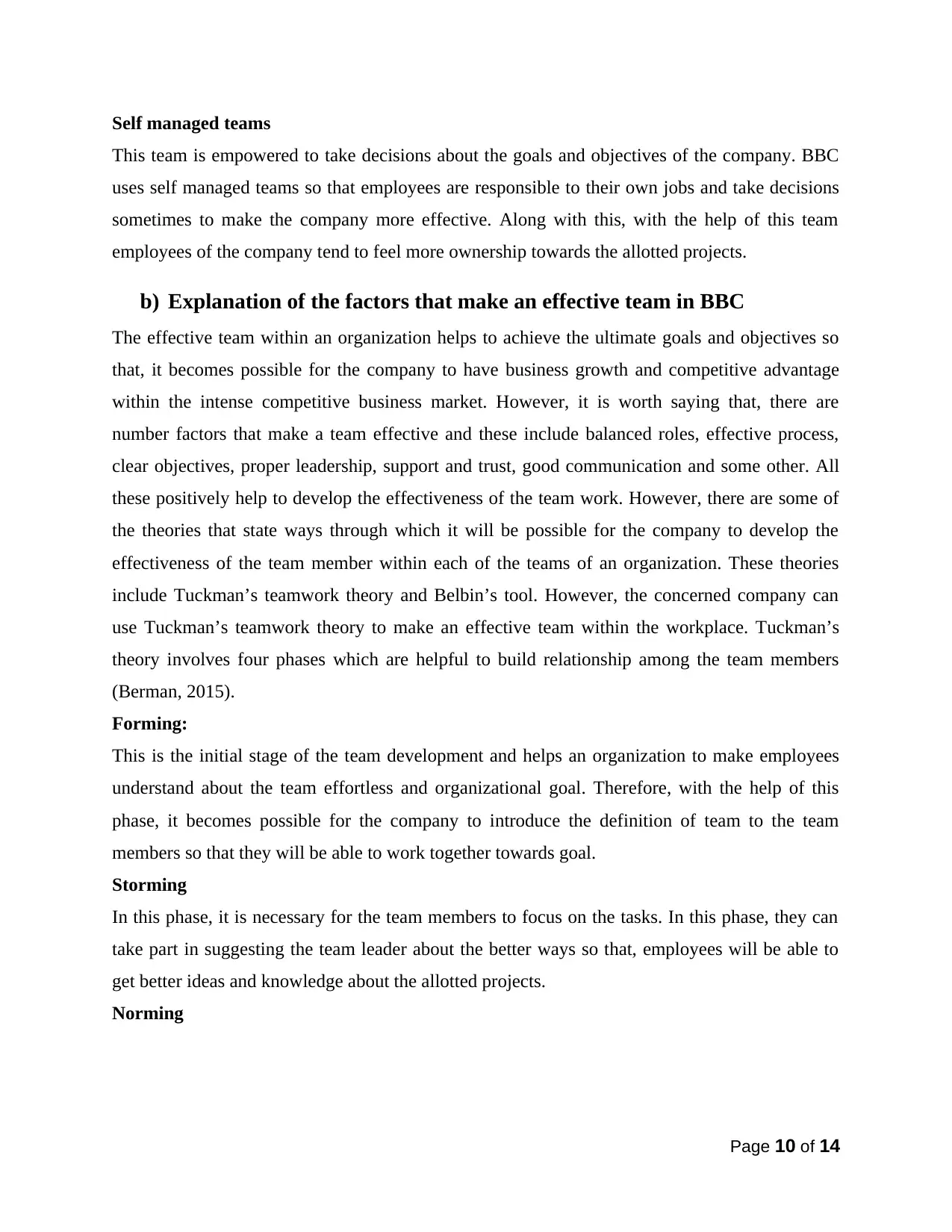
Self managed teams
This team is empowered to take decisions about the goals and objectives of the company. BBC
uses self managed teams so that employees are responsible to their own jobs and take decisions
sometimes to make the company more effective. Along with this, with the help of this team
employees of the company tend to feel more ownership towards the allotted projects.
b) Explanation of the factors that make an effective team in BBC
The effective team within an organization helps to achieve the ultimate goals and objectives so
that, it becomes possible for the company to have business growth and competitive advantage
within the intense competitive business market. However, it is worth saying that, there are
number factors that make a team effective and these include balanced roles, effective process,
clear objectives, proper leadership, support and trust, good communication and some other. All
these positively help to develop the effectiveness of the team work. However, there are some of
the theories that state ways through which it will be possible for the company to develop the
effectiveness of the team member within each of the teams of an organization. These theories
include Tuckman’s teamwork theory and Belbin’s tool. However, the concerned company can
use Tuckman’s teamwork theory to make an effective team within the workplace. Tuckman’s
theory involves four phases which are helpful to build relationship among the team members
(Berman, 2015).
Forming:
This is the initial stage of the team development and helps an organization to make employees
understand about the team effortless and organizational goal. Therefore, with the help of this
phase, it becomes possible for the company to introduce the definition of team to the team
members so that they will be able to work together towards goal.
Storming
In this phase, it is necessary for the team members to focus on the tasks. In this phase, they can
take part in suggesting the team leader about the better ways so that, employees will be able to
get better ideas and knowledge about the allotted projects.
Norming
Page 10 of 14
This team is empowered to take decisions about the goals and objectives of the company. BBC
uses self managed teams so that employees are responsible to their own jobs and take decisions
sometimes to make the company more effective. Along with this, with the help of this team
employees of the company tend to feel more ownership towards the allotted projects.
b) Explanation of the factors that make an effective team in BBC
The effective team within an organization helps to achieve the ultimate goals and objectives so
that, it becomes possible for the company to have business growth and competitive advantage
within the intense competitive business market. However, it is worth saying that, there are
number factors that make a team effective and these include balanced roles, effective process,
clear objectives, proper leadership, support and trust, good communication and some other. All
these positively help to develop the effectiveness of the team work. However, there are some of
the theories that state ways through which it will be possible for the company to develop the
effectiveness of the team member within each of the teams of an organization. These theories
include Tuckman’s teamwork theory and Belbin’s tool. However, the concerned company can
use Tuckman’s teamwork theory to make an effective team within the workplace. Tuckman’s
theory involves four phases which are helpful to build relationship among the team members
(Berman, 2015).
Forming:
This is the initial stage of the team development and helps an organization to make employees
understand about the team effortless and organizational goal. Therefore, with the help of this
phase, it becomes possible for the company to introduce the definition of team to the team
members so that they will be able to work together towards goal.
Storming
In this phase, it is necessary for the team members to focus on the tasks. In this phase, they can
take part in suggesting the team leader about the better ways so that, employees will be able to
get better ideas and knowledge about the allotted projects.
Norming
Page 10 of 14
Paraphrase This Document
Need a fresh take? Get an instant paraphrase of this document with our AI Paraphraser
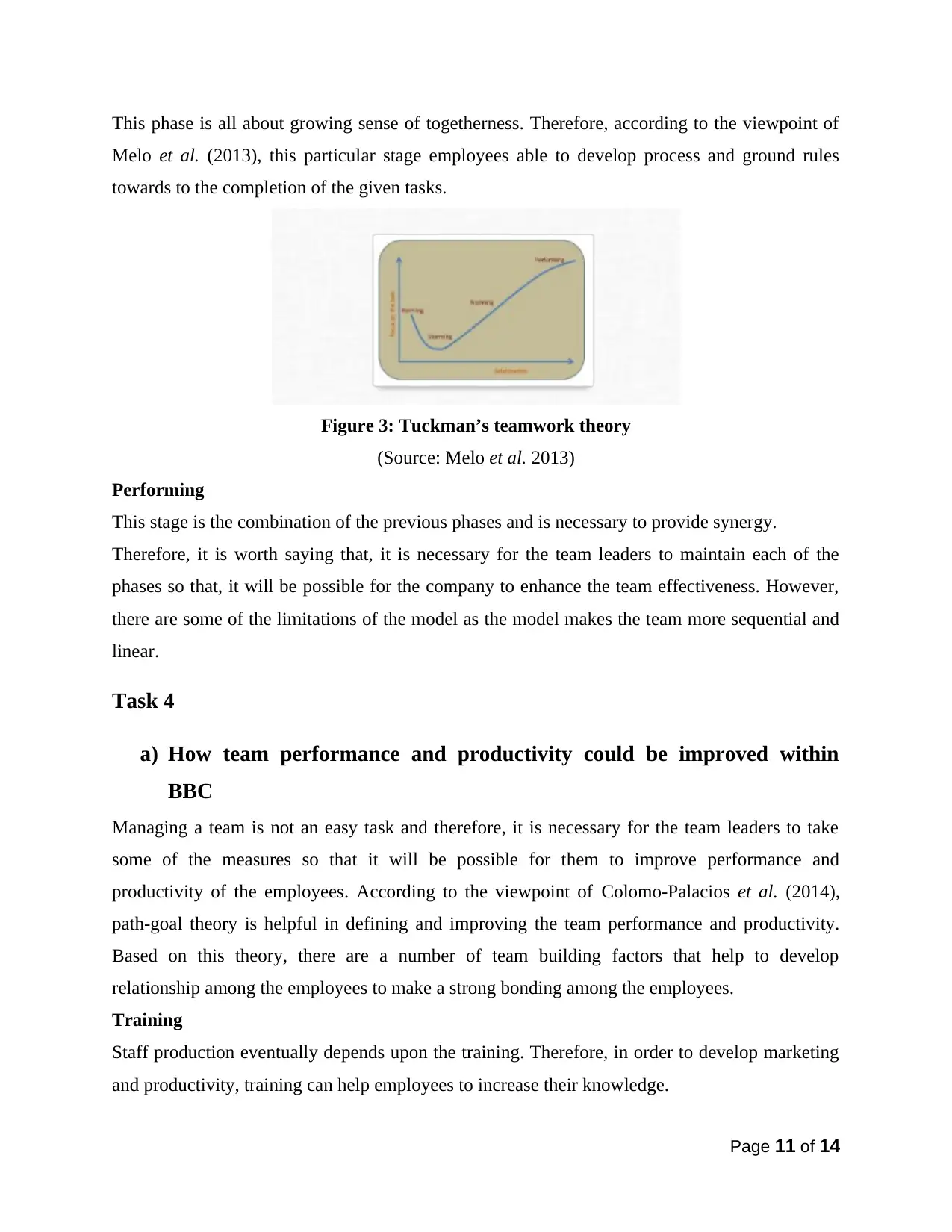
This phase is all about growing sense of togetherness. Therefore, according to the viewpoint of
Melo et al. (2013), this particular stage employees able to develop process and ground rules
towards to the completion of the given tasks.
Figure 3: Tuckman’s teamwork theory
(Source: Melo et al. 2013)
Performing
This stage is the combination of the previous phases and is necessary to provide synergy.
Therefore, it is worth saying that, it is necessary for the team leaders to maintain each of the
phases so that, it will be possible for the company to enhance the team effectiveness. However,
there are some of the limitations of the model as the model makes the team more sequential and
linear.
Task 4
a) How team performance and productivity could be improved within
BBC
Managing a team is not an easy task and therefore, it is necessary for the team leaders to take
some of the measures so that it will be possible for them to improve performance and
productivity of the employees. According to the viewpoint of Colomo-Palacios et al. (2014),
path-goal theory is helpful in defining and improving the team performance and productivity.
Based on this theory, there are a number of team building factors that help to develop
relationship among the employees to make a strong bonding among the employees.
Training
Staff production eventually depends upon the training. Therefore, in order to develop marketing
and productivity, training can help employees to increase their knowledge.
Page 11 of 14
Melo et al. (2013), this particular stage employees able to develop process and ground rules
towards to the completion of the given tasks.
Figure 3: Tuckman’s teamwork theory
(Source: Melo et al. 2013)
Performing
This stage is the combination of the previous phases and is necessary to provide synergy.
Therefore, it is worth saying that, it is necessary for the team leaders to maintain each of the
phases so that, it will be possible for the company to enhance the team effectiveness. However,
there are some of the limitations of the model as the model makes the team more sequential and
linear.
Task 4
a) How team performance and productivity could be improved within
BBC
Managing a team is not an easy task and therefore, it is necessary for the team leaders to take
some of the measures so that it will be possible for them to improve performance and
productivity of the employees. According to the viewpoint of Colomo-Palacios et al. (2014),
path-goal theory is helpful in defining and improving the team performance and productivity.
Based on this theory, there are a number of team building factors that help to develop
relationship among the employees to make a strong bonding among the employees.
Training
Staff production eventually depends upon the training. Therefore, in order to develop marketing
and productivity, training can help employees to increase their knowledge.
Page 11 of 14
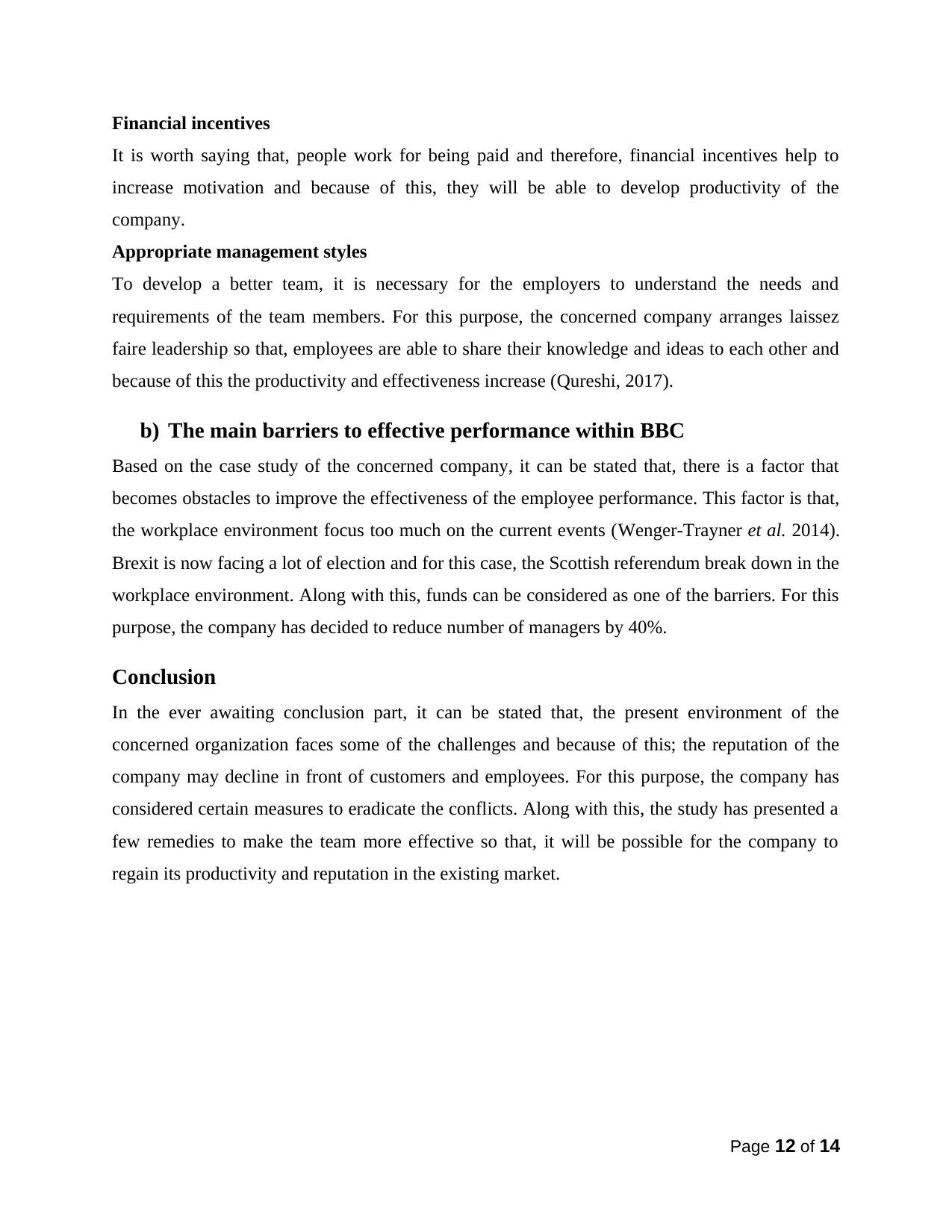
Financial incentives
It is worth saying that, people work for being paid and therefore, financial incentives help to
increase motivation and because of this, they will be able to develop productivity of the
company.
Appropriate management styles
To develop a better team, it is necessary for the employers to understand the needs and
requirements of the team members. For this purpose, the concerned company arranges laissez
faire leadership so that, employees are able to share their knowledge and ideas to each other and
because of this the productivity and effectiveness increase (Qureshi, 2017).
b) The main barriers to effective performance within BBC
Based on the case study of the concerned company, it can be stated that, there is a factor that
becomes obstacles to improve the effectiveness of the employee performance. This factor is that,
the workplace environment focus too much on the current events (Wenger-Trayner et al. 2014).
Brexit is now facing a lot of election and for this case, the Scottish referendum break down in the
workplace environment. Along with this, funds can be considered as one of the barriers. For this
purpose, the company has decided to reduce number of managers by 40%.
Conclusion
In the ever awaiting conclusion part, it can be stated that, the present environment of the
concerned organization faces some of the challenges and because of this; the reputation of the
company may decline in front of customers and employees. For this purpose, the company has
considered certain measures to eradicate the conflicts. Along with this, the study has presented a
few remedies to make the team more effective so that, it will be possible for the company to
regain its productivity and reputation in the existing market.
Page 12 of 14
It is worth saying that, people work for being paid and therefore, financial incentives help to
increase motivation and because of this, they will be able to develop productivity of the
company.
Appropriate management styles
To develop a better team, it is necessary for the employers to understand the needs and
requirements of the team members. For this purpose, the concerned company arranges laissez
faire leadership so that, employees are able to share their knowledge and ideas to each other and
because of this the productivity and effectiveness increase (Qureshi, 2017).
b) The main barriers to effective performance within BBC
Based on the case study of the concerned company, it can be stated that, there is a factor that
becomes obstacles to improve the effectiveness of the employee performance. This factor is that,
the workplace environment focus too much on the current events (Wenger-Trayner et al. 2014).
Brexit is now facing a lot of election and for this case, the Scottish referendum break down in the
workplace environment. Along with this, funds can be considered as one of the barriers. For this
purpose, the company has decided to reduce number of managers by 40%.
Conclusion
In the ever awaiting conclusion part, it can be stated that, the present environment of the
concerned organization faces some of the challenges and because of this; the reputation of the
company may decline in front of customers and employees. For this purpose, the company has
considered certain measures to eradicate the conflicts. Along with this, the study has presented a
few remedies to make the team more effective so that, it will be possible for the company to
regain its productivity and reputation in the existing market.
Page 12 of 14
⊘ This is a preview!⊘
Do you want full access?
Subscribe today to unlock all pages.

Trusted by 1+ million students worldwide
1 out of 14
Related Documents
Your All-in-One AI-Powered Toolkit for Academic Success.
+13062052269
info@desklib.com
Available 24*7 on WhatsApp / Email
![[object Object]](/_next/static/media/star-bottom.7253800d.svg)
Unlock your academic potential
Copyright © 2020–2025 A2Z Services. All Rights Reserved. Developed and managed by ZUCOL.





